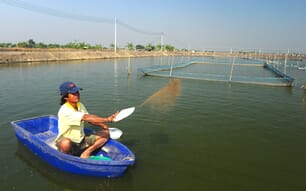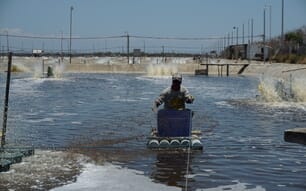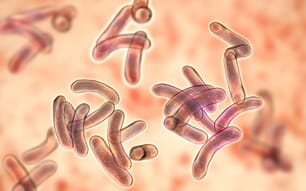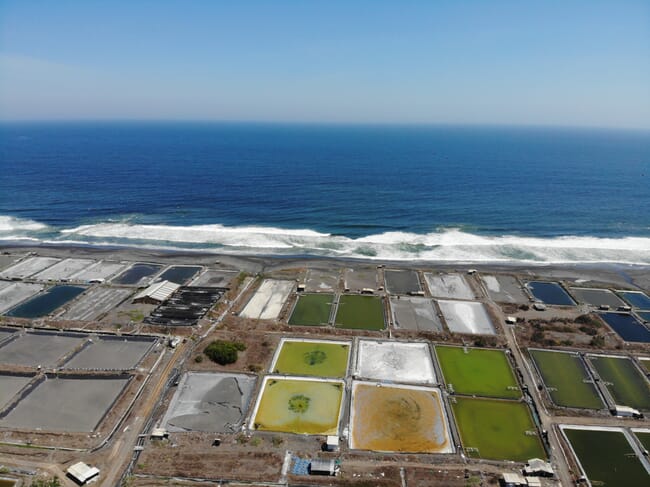
© Alune
In 2018, the FAO reported that world aquaculture production reached an all-time high of 114.5 million tonnes, worth $263.6 billion of farmgate sales. Crustacean production was 9.4 million tonnes, valued at $69.3 billion – 52.9 percent of which comes from Pacific whiteleg shrimp (Litopenaeus vannamei).
As aquaculture grows and the industry seeks stability to support sustained growth, the prevention, forecasting and management of disease is more relevant than ever. One of the most complex diseases in shrimp aquaculture, especially L. vannamei culture, is early mortality syndrome (EMS), which is also known as acute hepatopancreatic necrosis disease (AHPND).
Since its discovery in 2009, EMS/AHPND has been one of the main challenges in shrimp aquaculture. After it was detected in China, EMS has spread to multiple countries in southeast Asia. Due to its high mortality rate, many shrimp producing countries affected with EMS/AHPND have experienced a considerable reduction in production and export sales.
This article will delve deep to explore what EMS/AHPND is, the damage it causes and the various measures to prevent and combat EMS outbreaks.
What is EMS/AHPND?
In 2009, there was a serious disease outbreak which caused high shrimp mortalities of L. vannamei and P. monodon in southern China. Researchers initially called this disease early mortality syndrome (EMS) or acute hepatopancreatic necrosis syndrome (AHPNS). By 2010, more farms in China were affected and, in 2011, EMS/AHPNS was detected in Vietnam and Malaysia. The disease was also confirmed in Thailand in 2012.
Researchers were initially baffled by the cause of EMS/AHPNS. There were some hypotheses, such as environmental toxins and infectious agents, but studies in these areas failed.
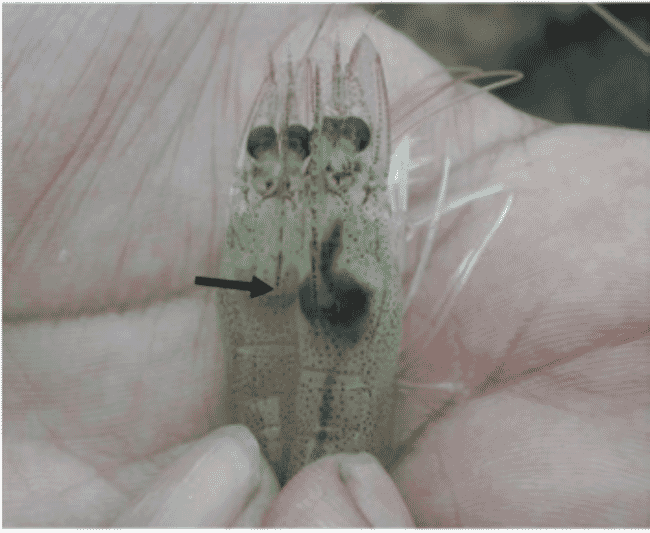
The puzzle was solved in 2013 by Loc Tran and his team's breakthrough discovery that it was caused by a strain of bacterium, Vibrio parahaemolyticus, which are ubiquitous in culture water. With a better knowledge of the infectious agent, a proper name for EMS/AHPNS was suggested, namely acute hepatopancreatic necrosis disease (AHPND).
AHPND infects juveniles or post-larvae (PL) L. vannamei and P. monodon, with 100 percent mortality rate within 10 to 35 days after stocking. The bacteria V. parahaemolyticus, which is naturally found in coastal and estuarine waters and causes EMS/AHPND, contains two toxic genes – Pir A and Pir B. Non-V. Parahaemolyticus such as V. campbellii, V. harveyi, V. owensii, and V. punensis are also found to contain the toxic genes and may cause EMS/AHPND. Under low biosecurity regimes, the bacteria can easily spread between ponds and neighbouring farms via water effluent.
EMS/AHPND can be detected by looking at the physical signs of shrimp, including pale, shrunken or atrophied hepatopancreas, soft shells, and partially full to consistently empty guts. However, to confirm the disease, a histological examination in the laboratory is required. In the acute phase, shrimp infected with AHPND will show sloughing of tubule epithelial cells in the hepatopancreas, as shown in Picture 2.
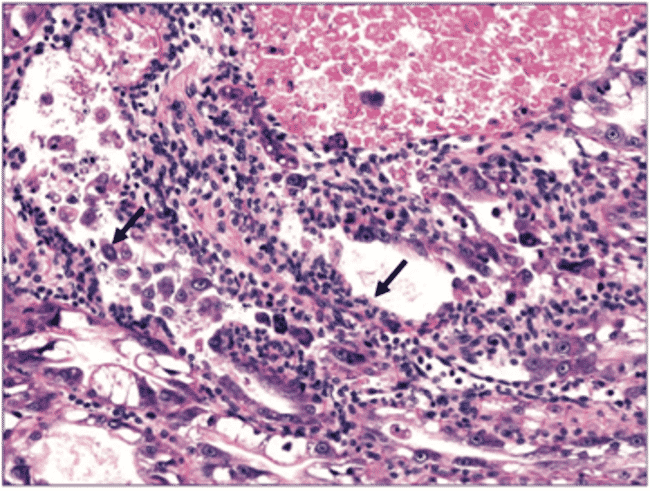
Hatcheries are one of the main sources of EMS/AHPND – spreading the disease through infected PL, which may cause an outbreak as early as 14 days after stocking. The disease can also spread via cross-contamination – where the pathogen enters ponds through equipment, shoes/feet, birds or crabs – or if it was not removed from the pond’s previous production cycle. The shrimp are more susceptible to infection under certain environmental conditions which promote bacteria proliferation. These factors include:
- High level of nutrients in pond water from the addition of fertilisers or molasses.
- Water with high temperature, salinity of >5 ppt, and pH of >7.
- Poor water circulation and low plankton biodiversity.
- Build-up of organic sediments, such as unconsumed feed and shrimp carcasses.
Losses caused by EMS/AHPND
EMS/AHPND has been wreaking havoc in Asian shrimp aquaculture over the last 10 years. As seen in Figure 1, one of the most affected countries in the region is Thailand, which was second largest shrimp producer in the world after China pre-AHPND and has now fallen to the sixth spot.
Since the outbreak of EMS/AHPND in 2012, Thai shrimp production has experienced a significant loss. Total production fell by 54 percent between 2009 and 2014. The number of farms also decreased by 16 percent, while the land area used for shrimp production fell by 10 percent. Another report stated that between 2010–2016, the disease caused financial losses of $11.58 billion in Thailand and more than 100,000 job losses.

Other affected countries have not suffered as much as Thailand, but losses are still significant. In Vietnam, for instance, AHPND has caused a $2.56 billion loss since its first emergence in 2011. Many shrimp producing countries affected by AHPND are still recovering from the outbreak and many other unaffected countries are preparing prevention measures to stop its spread.
Learning from Thailand
As a shrimp-producing country that suffered the biggest blow, Thailand is still recovering from the EMS/AHPND outbreak. Farmers in Thailand have started to shift their farming practices to counteract Vibrio spp. bacteria infection and prevent another outbreak.
A new intensive farm design has been developed, which aims to maintain a clean pond bottom. The new design is based on recirculation and flow-through systems, with four important components:
- Increased water treatment areas
- Smaller grow-out pond size
- Central drain/shrimp toilet
- Increased aeration
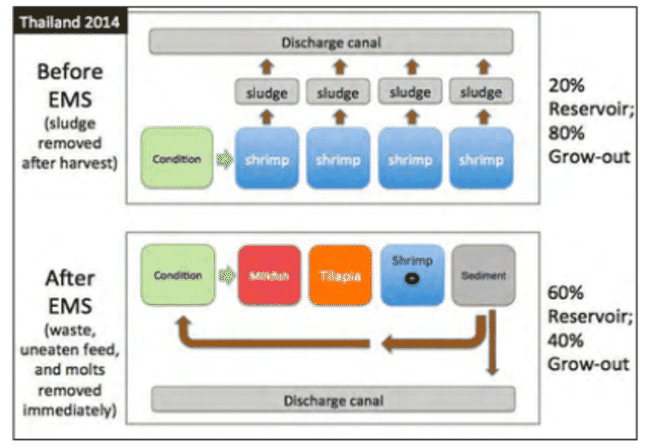
The ratio of reservoirs to grow-out ponds has been drastically changed – from 20%:80% to 60%:40%. The increased volume of reservoirs provides more water storage and makes more water exchange possible – helping to minimise disease risks and manage water quality. Supported with tilapia and/or milkfish polyculture, the water from pre-treatment areas is transferred to the tilapia or milkfish ponds, which are stocked with fish at a density of 1–2 kg/m2. Both organisms can help maintain good water quality and improve sediment quality by grazing organic wastes in the water.
The water is then transferred to the grow-out pond, which is equipped with HDPE plastic liners used to avoid pond bottom erosion due to high aeration. The grow-out pond size is reduced to optimise the oxygenation process whilst efficiently utilising water movement to push the sediment towards the shrimp toilet. The reduced surface area – from the average of 8,000m2 to 1,500m2, or even as small as 500m2 – is compensated for by a water column up to 3 metres deep, in order to provide a greater stocking density.
Meanwhile the shrimp toilets are utilised to collect sediment in one place so that it can be removed easily. The recommended surface area for the shrimp toilet is 5–7 percent of the total pond area and pond bottoms should have a slope of 25–30 degrees and be lined with plastic to make the sediment fall inside more easily. Non-stop aeration is needed to make sure that the sediment is pushed to the toilet. The energy budget for aeration may vary, depending on pond depth and area, but the usual is around 70 to 100 horse power (hp) of energy per hectare.
When the cycle is finished, the water will be transferred back to the pre-treatment area. This is done to reduce the intake of water which may have high pathogen load. As a result, it reduces the risk of pathogen spread from outside sources, as well as the volume of effluent output. It also increases the farm's sustainability.
As seen in Figure 3, Thailand’s shrimp production is growing. These new systems require investment in infrastructure and improved management teams. This transition takes time and requires significant national consensus and fiscal support, which has led to the dramatic consolidation of the industry. It should be noted that Thailand has other conditions, such as tax and national industry structuring, which have further limited the sector’s expansion post-EMS.
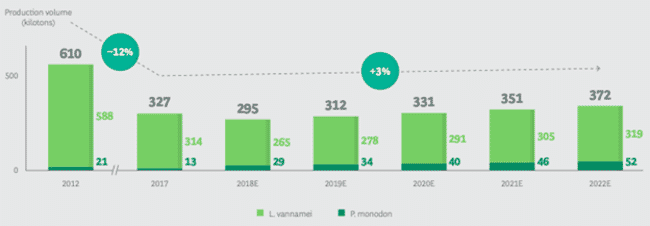
Best practices for managing EMS/AHPND
There is no quick fix for EMS/AHPND – once a farm is infected a carefully balanced management plan is required. In a worst-case scenario, farmers should be prepared to harvest all ponds at short notice. There must be a strong commitment by all team members to implement strict biosecurity measures and a thorough disinfection phase to manage the disease and avoid future outbreaks.
Biosecurity is a concept for preventing disease infection and preventing the disease from spreading across boundaries. The two dominant approaches in biosecurity practices are preventive measures – the exclusion of pathogens – and countermeasures that eliminate pathogens. We can manage EMS/AHPND by preventing its further spread and providing better conditions to increase shrimp resistance to it.
Here are some of the best practices for managing EMS/AHPND in infected farms, covering all steps of production.
Preparing for the production cycle
- PL need to be derived from AHPND-free broodstock. The general health of PL should be checked before stocking, including in stress tests.
- All facilities should be disinfected prior to stocking. Using multiple disinfectant agents helps to remove all pathogen vectors.
- The grow-out pond should be lined with HDPE plastic liners for easy cleaning and control.
- Before stocking, ponds should be completely dried. Water should also be conditioned for 10–15 days before the shrimp are stocked.
- A thorough biosecurity plan should be implemented and reviewed after every cycle.
- Protect the farm from outside species, for instance by using crab protecting devices.
- To avoid infection, stocking should be done in a single area at the same time. It is recommended to stock into water which has Vibrio of less than 1 x 10^3 CFU/ml – ie where these species make up less than 1 percent of the total bacteria concentration.
Mitigating EMS during grow-out
- Water quality parameters – including levels of pH, alkalinity, salinity, dissolved oxygen (DO), ammonia nitrogen and hydrogen sulphide – should be monitored regularly.
- Shrimp health should be monitored every three days, this should include cramping and hepatopancreas checks.
- The feeding regime should be adjusted to avoid overfeeding and feeds containing a protein content of over 30 percent is suggested.
- The sediment should be siphoned regularly.
- Proper aeration should be maintained.
- Probiotics should be applied regularly and be increased where stress events or water exchanges occur.
- Agree water outlet and intake regimes with all farms in the area to reduce transferring pathogens between farms.
- At the first sign of disease, a management plan must be enacted. Where disease is suspected, a confirmatory lab test should be used.
Long-term EMS solutions: infrastructure and technology
Maintaining the right equipment and infrastructure on the farm will make biosecurity maintenance and pathogens defense easier, resulting in more stable financial returns. The infrastructure needed to maintain biosecurity and defence against pathogens includes HDPE lining, foot, vehicle and hand wash stations, as well as fencing and netting to prevent people and animals from entering the farm.
Other important infrastructure includes dedicated water inlets and outlets, a central drain, pre-treatment ponds with a volume of at least 30 percent of the grow-out ponds, post-treatment, 10 hp of aeration per 1000m2 with good currents, nursery stages, storage facilities and a basic on-site laboratory with strong lighting for dissection and basic water testing.
There are also emerging technologies that can offer advanced detection and enable better management of pathogens. One company rapidly disrupting what disease detection means for the industry is Genics, which offers a new way to detect pathogens and their density with the Shrimp MultiPath technology. The test can detect disease up to 10 days before clinical signs and subsequent mortalities – buying farmers precious time to decide suitable mitigation strategies as early as possible and reduce the risk of an outbreak.
Moving forward from EMS
EMS can be a devastating disease but – as has been proven in Thailand and Vietnam – investing in infrastructure, strict biosecurity and frequent farm management reviews can help defend against the disease and reduce its impact if it enters the farm. The industry must take a proactive, preventative view to EMS/AHPND as it should to all pathogens, known and unknown. By planning for the worst and operating for the best, farmers have a better chance of producing successful crops, even in areas with high disease prevalence.
In addition to this quick overview on EMS, farmers should read other articles, attend national and international webinars and join local events where they can learn more and share ideas about disease prevention and mitigation.
The Alune farming experts will be sharing their experiences and research in regular articles on The Fish Site as part of the Closer to shrimp aquaculture series.
*Alune is part of Hatch’s portfolio, but The Fish Site remains editorially independent.


